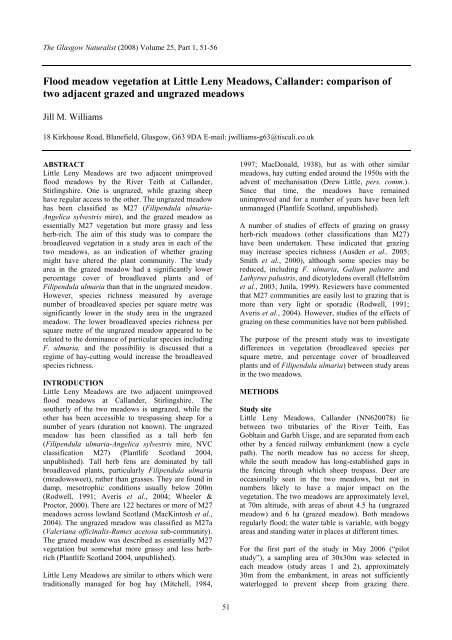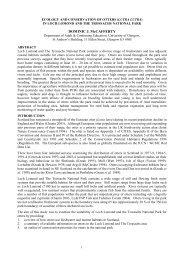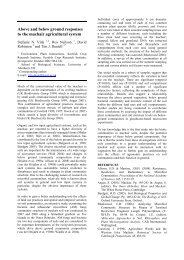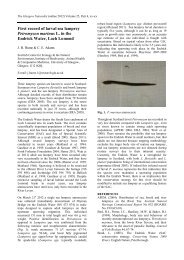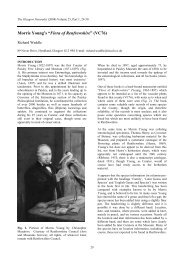Flood meadow vegetation at Little Leny Meadows, Callander
Flood meadow vegetation at Little Leny Meadows, Callander
Flood meadow vegetation at Little Leny Meadows, Callander
You also want an ePaper? Increase the reach of your titles
YUMPU automatically turns print PDFs into web optimized ePapers that Google loves.
The Glasgow N<strong>at</strong>uralist (2008) Volume 25, Part 1, 51-56<br />
<strong>Flood</strong> <strong>meadow</strong> <strong>veget<strong>at</strong>ion</strong> <strong>at</strong> <strong>Little</strong> <strong>Leny</strong> <strong>Meadows</strong>, <strong>Callander</strong>: comparison of<br />
two adjacent grazed and ungrazed <strong>meadow</strong>s<br />
Jill M. Williams<br />
18 Kirkhouse Road, Blanefield, Glasgow, G63 9DA E-mail: jwilliams-g63@tiscali.co.uk<br />
ABSTRACT<br />
<strong>Little</strong> <strong>Leny</strong> <strong>Meadows</strong> are two adjacent unimproved<br />
flood <strong>meadow</strong>s by the River Teith <strong>at</strong> <strong>Callander</strong>,<br />
Stirlingshire. One is ungrazed, while grazing sheep<br />
have regular access to the other. The ungrazed <strong>meadow</strong><br />
has been classified as M27 (Filipendula ulmaria-<br />
Angelica sylvestris mire), and the grazed <strong>meadow</strong> as<br />
essentially M27 <strong>veget<strong>at</strong>ion</strong> but more grassy and less<br />
herb-rich. The aim of this study was to compare the<br />
broadleaved <strong>veget<strong>at</strong>ion</strong> in a study area in each of the<br />
two <strong>meadow</strong>s, as an indic<strong>at</strong>ion of whether grazing<br />
might have altered the plant community. The study<br />
area in the grazed <strong>meadow</strong> had a significantly lower<br />
percentage cover of broadleaved plants and of<br />
Filipendula ulmaria than th<strong>at</strong> in the ungrazed <strong>meadow</strong>.<br />
However, species richness measured by average<br />
number of broadleaved species per square metre was<br />
significantly lower in the study area in the ungrazed<br />
<strong>meadow</strong>. The lower broadleaved species richness per<br />
square metre of the ungrazed <strong>meadow</strong> appeared to be<br />
rel<strong>at</strong>ed to the dominance of particular species including<br />
F. ulmaria, and the possibility is discussed th<strong>at</strong> a<br />
regime of hay-cutting would increase the broadleaved<br />
species richness.<br />
INTRODUCTION<br />
<strong>Little</strong> <strong>Leny</strong> <strong>Meadows</strong> are two adjacent unimproved<br />
flood <strong>meadow</strong>s <strong>at</strong> <strong>Callander</strong>, Stirlingshire. The<br />
southerly of the two <strong>meadow</strong>s is ungrazed, while the<br />
other has been accessible to trespassing sheep for a<br />
number of years (dur<strong>at</strong>ion not known). The ungrazed<br />
<strong>meadow</strong> has been classified as a tall herb fen<br />
(Filipendula ulmaria-Angelica sylvestris mire, NVC<br />
classific<strong>at</strong>ion M27) (Plantlife Scotland 2004,<br />
unpublished). Tall herb fens are domin<strong>at</strong>ed by tall<br />
broadleaved plants, particularly Filipendula ulmaria<br />
(<strong>meadow</strong>sweet), r<strong>at</strong>her than grasses. They are found in<br />
damp, mesotrophic conditions usually below 200m<br />
(Rodwell, 1991; Averis et al., 2004; Wheeler &<br />
Proctor, 2000). There are 122 hectares or more of M27<br />
<strong>meadow</strong>s across lowland Scotland (MacKintosh et al.,<br />
2004). The ungrazed <strong>meadow</strong> was classified as M27a<br />
(Valeriana officinalis-Rumex acetosa sub-community).<br />
The grazed <strong>meadow</strong> was described as essentially M27<br />
<strong>veget<strong>at</strong>ion</strong> but somewh<strong>at</strong> more grassy and less herbrich<br />
(Plantlife Scotland 2004, unpublished).<br />
<strong>Little</strong> <strong>Leny</strong> <strong>Meadows</strong> are similar to others which were<br />
traditionally managed for bog hay (Mitchell, 1984,<br />
51<br />
1997; MacDonald, 1938), but as with other similar<br />
<strong>meadow</strong>s, hay cutting ended around the 1950s with the<br />
advent of mechanis<strong>at</strong>ion (Drew <strong>Little</strong>, pers. comm.).<br />
Since th<strong>at</strong> time, the <strong>meadow</strong>s have remained<br />
unimproved and for a number of years have been left<br />
unmanaged (Plantlife Scotland, unpublished).<br />
A number of studies of effects of grazing on grassy<br />
herb-rich <strong>meadow</strong>s (other classific<strong>at</strong>ions than M27)<br />
have been undertaken. These indic<strong>at</strong>ed th<strong>at</strong> grazing<br />
may increase species richness (Ausden et al., 2005;<br />
Smith et al., 2000), although some species may be<br />
reduced, including F. ulmaria, Galium palustre and<br />
L<strong>at</strong>hyrus palustris, and dicotyledons overall (Hellström<br />
et al., 2003; Jutila, 1999). Reviewers have commented<br />
th<strong>at</strong> M27 communities are easily lost to grazing th<strong>at</strong> is<br />
more than very light or sporadic (Rodwell, 1991;<br />
Averis et al., 2004). However, studies of the effects of<br />
grazing on these communities have not been published.<br />
The purpose of the present study was to investig<strong>at</strong>e<br />
differences in <strong>veget<strong>at</strong>ion</strong> (broadleaved species per<br />
square metre, and percentage cover of broadleaved<br />
plants and of Filipendula ulmaria) between study areas<br />
in the two <strong>meadow</strong>s.<br />
METHODS<br />
Study site<br />
<strong>Little</strong> <strong>Leny</strong> <strong>Meadows</strong>, <strong>Callander</strong> (NN620078) lie<br />
between two tributaries of the River Teith, Eas<br />
Gobhain and Garbh Uisge, and are separ<strong>at</strong>ed from each<br />
other by a fenced railway embankment (now a cycle<br />
p<strong>at</strong>h). The north <strong>meadow</strong> has no access for sheep,<br />
while the south <strong>meadow</strong> has long-established gaps in<br />
the fencing through which sheep trespass. Deer are<br />
occasionally seen in the two <strong>meadow</strong>s, but not in<br />
numbers likely to have a major impact on the<br />
<strong>veget<strong>at</strong>ion</strong>. The two <strong>meadow</strong>s are approxim<strong>at</strong>ely level,<br />
<strong>at</strong> 70m altitude, with areas of about 4.5 ha (ungrazed<br />
<strong>meadow</strong>) and 6 ha (grazed <strong>meadow</strong>). Both <strong>meadow</strong>s<br />
regularly flood; the w<strong>at</strong>er table is variable, with boggy<br />
areas and standing w<strong>at</strong>er in places <strong>at</strong> different times.<br />
For the first part of the study in May 2006 (“pilot<br />
study”), a sampling area of 30x30m was selected in<br />
each <strong>meadow</strong> (study areas 1 and 2), approxim<strong>at</strong>ely<br />
30m from the embankment, in areas not sufficiently<br />
w<strong>at</strong>erlogged to prevent sheep from grazing there.
Inspection in early June indic<strong>at</strong>ed th<strong>at</strong> the grazed<br />
<strong>meadow</strong> study area was somewh<strong>at</strong> unrepresent<strong>at</strong>ive,<br />
with a drier grass sward and some plants <strong>at</strong>ypical of the<br />
rest of the <strong>meadow</strong>, in particular Conopodium majus.<br />
Therefore, for the second part of the study in July 2006<br />
(“main study”), a study area more represent<strong>at</strong>ive of the<br />
grazed <strong>meadow</strong> as a whole was used, 60m further to<br />
the east (study area 3). For each study area, random<br />
number tables were used to gener<strong>at</strong>e loc<strong>at</strong>ions for the<br />
sampling quadr<strong>at</strong>s (15 in study areas 1 and 2 in the<br />
pilot study, 30 in study areas 1 and 3 in the main<br />
study).<br />
Study measurements<br />
In the pilot study, total percentage cover of<br />
broadleaved plants and of Filipendula ulmaria was<br />
measured <strong>at</strong> each of the 15 sampling loc<strong>at</strong>ions in the<br />
two study areas (1 and 2), using a 0.5m point quadr<strong>at</strong><br />
(number of “hits” out of 20 converted to a percentage),<br />
and median and range for the grazed and ungrazed<br />
study areas were calcul<strong>at</strong>ed.<br />
In the main study, all the broadleaved species rooted in<br />
one square metre <strong>at</strong> each of the 30 sampling loc<strong>at</strong>ions<br />
in the two study areas (1 and 3) were identified. The<br />
sample mean () and standard devi<strong>at</strong>ion (s) for number<br />
of species per square metre was calcul<strong>at</strong>ed for each<br />
study area, and the grazed and ungrazed study areas<br />
were then compared using the z-test for large<br />
unm<strong>at</strong>ched samples. Broadleaved species per square<br />
metre were also calcul<strong>at</strong>ed in the pilot study, but with<br />
only preliminary analysis (not reported here).<br />
RESULTS<br />
Percentage cover of broadleaved plants and<br />
<strong>meadow</strong>sweet<br />
In the pilot study in May, total percentage cover of<br />
broadleaved plants was much higher in the study area<br />
in the ungrazed <strong>meadow</strong> (study area 1, median 95.0%,<br />
range 65-100%, n=15) than in th<strong>at</strong> in the grazed<br />
<strong>meadow</strong> (study area 2, median 37.5%, range 5-65%,<br />
n=15). Percentage cover of F. ulmaria was also much<br />
higher in the ungrazed <strong>meadow</strong> study area (median<br />
57.5%, range 25-100%, n=15) than in the grazed<br />
<strong>meadow</strong> area. In the l<strong>at</strong>ter, F. ulmaria was present in<br />
only 10 of the 15 quadr<strong>at</strong>s, and cover in many of these<br />
was
Species Frequency of occurrence<br />
Main study (July 06) Pilot study (May 06)<br />
Ungrazed Grazed Ungrazed Grazed<br />
(Area 1) (Area 3) (Area 1) (Area 2)<br />
Angelica sylvestris Wild angelica I (3%) V (90%) - I (13%)<br />
Filipendula ulmaria <strong>Meadows</strong>weet V (100%) V (100%) V (100%) IV (67%)<br />
L<strong>at</strong>hyrus pr<strong>at</strong>ensis Meadow vetchling V (97%) V (83%) IV (80%) IV (73%)<br />
Lotus peduncul<strong>at</strong>us Gre<strong>at</strong>er bird’s-foot-trefoil I (10%) V (90%) I (7%) IV (80%)<br />
Potentilla erecta Tormentil II (23%) V (93%) I (20%) IV (80%)<br />
Ranunculus<br />
Buttercup species V (87%) V (100%) IV (67%) II (40%)<br />
acris/repens<br />
Rumex acetosa Common sorrel V (87%) V (100%) V (100%) V (93%)<br />
Valeriana officinalis Common valerian V (97%) III (53%) V (93%) I (20%)<br />
Achillea ptarmica Sneezewort III (47%) III (47%) III (47%) -<br />
Epilobium palustre Marsh willowherb III (43%) I (17%) II (27%) -<br />
Galium aparine Cleavers III (47%) - II (33%) I (7%)<br />
Galium sp. (A) + Bedstraw species (A) II (40%) III (57%) III (60%) II (40%)<br />
Plantago lanceol<strong>at</strong>a Ribwort plantain - III (60%) - -<br />
Veronica chamaedrys Germander speedwell I (7%) III (50%) I (7%) II (33%)<br />
Centaurea nigra Black knapweed I (13%) II (33%) - I (7%)<br />
Ajuga reptans Bugle - I (13%) - -<br />
Caltha palustris Marsh-marigold - I (7%) - -<br />
Cardamine spp. Bittercress/cuckooflower I (10%) - - -<br />
Galium sp. (B) + Bedstraw species (B) - I (10%) I (13%) I (20%)<br />
Heracleum<br />
Hogweed I (20%) - I (7%) -<br />
sphondylium<br />
Hypericum x<br />
desetangsii<br />
Hybrid between perfor<strong>at</strong>e/imperfor<strong>at</strong>e<br />
St John’s-wort<br />
53<br />
I (3%) - - -<br />
Rumex obtusifolius Broad-leaved dock I (3%) - - -<br />
Senecio aqu<strong>at</strong>icus Marsh ragwort I (3%) - - -<br />
Stachys palustris Marsh woundwort I (17%) - I (13%) -<br />
Stellaria graminea Lesser stitchwort I (13%) I (20%) I (7%) II (33%)<br />
Taraxacum agg. Dandelion - I (13%) - -<br />
Vicia sp. Vetch species - I (10%) I (7%) I (20%)<br />
Viola palustris Marsh violet - I (7%) - -<br />
Unidentified species (C) - I (7%) - -<br />
+ (A) and (B) were neither G. boreale nor G. aparine<br />
Table 1. List of broadleaved species recorded during main study (July 06), with frequencies of occurrence in the main<br />
and pilot studies (frequency code and % of total quadr<strong>at</strong>s sampled). Key: V/IV Constants (81-100% / 61-80%); III<br />
Common (41-60%); II Occasional (21-40%); I Scarce (1-20%).
Species Frequency of occurrence<br />
Ungrazed Grazed<br />
(Area 1) (Area 2)<br />
Anemone nemorosa Wood anemone V (93%)<br />
Conopodium majus Pignut V (87%)<br />
Ranunculus ficaria Lesser celandine V (93%) I (20%)<br />
Umbellifer species<br />
[Unidentifiied: small plants,<br />
appeared to be single species]<br />
V (87%)<br />
Cardamine pr<strong>at</strong>ensis* Cuckoo flower III (47%) I (7%)<br />
Cardamine amara* Large bittercress II (33%)<br />
Epilobium montanum Broad-leaved willowherb I (7%)<br />
Geranium sylv<strong>at</strong>icum Wood crane’s-bill I (20%)<br />
Trifolium sp. Clover I (7%)<br />
Unidentified species (D) I (20%) I (7%)<br />
(* Small number of plants of Cardamine spp. seen in main study)<br />
Table 2. List of broadleaved species recorded only during pilot study (May 06) (frequency<br />
code and % of total quadr<strong>at</strong>s sampled). Key: V/IV Constants (81-100% / 61-80%); III<br />
Common (41-60%); II Occasional (21-40%); I Scarce (1-20%).<br />
DISCUSSION<br />
In this study there were significantly more species per<br />
square metre in the grazed than in the ungrazed study<br />
area, and it is possible this was rel<strong>at</strong>ed to the presence<br />
and absence of grazing. Although in previous studies<br />
grazing increased species richness of grassy herb-rich<br />
<strong>meadow</strong>s, it had been anticip<strong>at</strong>ed th<strong>at</strong> in the case of<br />
M27 tall herb communities, any effect of grazing<br />
would be in the direction of reduced species richness if<br />
many of the tall herb species were not tolerant of<br />
grazing. It is possible however th<strong>at</strong> the lower species<br />
richness per square metre in the ungrazed study area in<br />
this study was rel<strong>at</strong>ed to the high level of dominance of<br />
F. ulmaria itself, whose dense canopy (with other<br />
species, particularly Valeriana officinalis) may have<br />
limited the ability of smaller plants to compete.<br />
Percentage cover of broadleaved plants and of<br />
Filipendula ulmaria was much lower in the grazed than<br />
in the ungrazed study area in May, when measured in<br />
the pilot study, and this difference was still clearly<br />
visible in July in the more represent<strong>at</strong>ive grazed study<br />
area, with grasses and rushes forming the remainder of<br />
the cover. It may have been the grazing th<strong>at</strong> was<br />
responsible for this difference. In previous studies of<br />
other plant communities by Hellström et al. (2003) and<br />
Jutila (1999), abundance of F. ulmaria was lower in<br />
grazed than ungrazed quadr<strong>at</strong>s. There are conflicting<br />
references to the pal<strong>at</strong>ability of F. ulmaria to grazing<br />
stock (Mitchell, 1984; Rodwell, 1991). The plant<br />
contains salicyl<strong>at</strong>e (Dickson & Dickson, 2000, p.268),<br />
and it is possible th<strong>at</strong> this may limit the extent to which<br />
stock e<strong>at</strong> it, and th<strong>at</strong> trampling by stock may be a more<br />
important factor in the effect of grazing (A. McBride,<br />
pers. comm.). If the lower cover of F. ulmaria (and of<br />
other broadleaved plants) in the present study was due<br />
to sheep grazing, it cannot be ascertained whether this<br />
was a direct result of the plants being e<strong>at</strong>en, an effect<br />
due to trampling, or an effect of sheep on soil<br />
characteristics.<br />
54<br />
Species Ungrazed Grazed<br />
<strong>meadow</strong> <strong>meadow</strong><br />
Broadleaved species not<br />
recorded in quadr<strong>at</strong>s<br />
Fallopia Japanese<br />
√ *<br />
japonica knotweed<br />
Galium Northern √<br />
boreale bedstraw<br />
Iris<br />
pseudacorus<br />
Yellow iris √<br />
Lychnis Ragged- √<br />
floscuculi robin<br />
Potentilla Marsh<br />
√<br />
palustris cinquefoil<br />
Trollius<br />
europaeus<br />
Globeflower √<br />
Sedges (Carex spp.)<br />
Carex curta √ # √<br />
C. nigra √<br />
C. rostr<strong>at</strong>a √<br />
C. vesicaria √ √<br />
* On river bank<br />
# Seen in three quadr<strong>at</strong>s in ungrazed <strong>meadow</strong> (main<br />
study)<br />
Table 3. Broadleaved species (other than those<br />
recorded in quadr<strong>at</strong>s) and sedges (Carex spp.) noted<br />
during the study.
None of the more frequent ungrazed <strong>meadow</strong> species<br />
(those present in more than 20% of quadr<strong>at</strong>s) was<br />
absent from the grazed study area. If the differences in<br />
<strong>veget<strong>at</strong>ion</strong> found in this study were due to grazing, it<br />
therefore seems likely th<strong>at</strong> the grazed <strong>meadow</strong> in its<br />
present condition could revert to a more characteristic<br />
M27 or similar community if grazing sheep were<br />
excluded. However, the small size and gre<strong>at</strong>ly reduced<br />
cover of the broadleaved plants indic<strong>at</strong>es th<strong>at</strong> if grazing<br />
were to continue, some of these species might<br />
eventually be lost completely from the <strong>meadow</strong>.<br />
The study area in the ungrazed <strong>meadow</strong> (where the<br />
current regime is no management) had a highly<br />
dominant cover of F. ulmaria. The average of 7.7<br />
broadleaved species per square metre compares with a<br />
range of 8-28 total species per sample for 29 M27a<br />
communities (sample size usually 2x2 m 2 ; grasses and<br />
rushes included), (Rodwell, 1991). Rodwell comments<br />
th<strong>at</strong> F. ulmaria can be highly dominant in M27<br />
communities, and this indic<strong>at</strong>es lower diversity, as the<br />
l<strong>at</strong>ter is inversely rel<strong>at</strong>ed to dominance (Open<br />
University, 2001, p.131).<br />
Many M27 and similar <strong>meadow</strong>s in Scotland were<br />
formerly hay <strong>meadow</strong>s (Mitchell, 1984, 1997;<br />
MacDonald, 1938). <strong>Little</strong> <strong>Leny</strong> <strong>Meadows</strong> were cut for<br />
hay until mechanis<strong>at</strong>ion in the 1950s (D. <strong>Little</strong>, pers.<br />
comm.). It is possible th<strong>at</strong> such a hay-cutting regime<br />
might reduce the dominance of F. ulmaria in the<br />
ungrazed <strong>meadow</strong> and increase the number of species<br />
per square metre. In a management study of a<br />
Filipendula ulmaria mire in southwest Scotland<br />
(McBride, unpublished), a regime of autumn hay<br />
cutting and removal decreased the vigour and<br />
dominance of Filipendula ulmaria and increased<br />
species diversity compared with uncut quadr<strong>at</strong>s. This<br />
could be tried in experimental plots in <strong>Little</strong> <strong>Leny</strong><br />
<strong>Meadows</strong>.<br />
A limit<strong>at</strong>ion of the present study was th<strong>at</strong> each phase of<br />
the study included only one study area in each of the<br />
two <strong>meadow</strong>s (areas 1 and 2 in the pilot, and areas 1<br />
and 3 in the main study). Therefore, tre<strong>at</strong>ment effects<br />
(grazing or no grazing) could not be separ<strong>at</strong>ed from<br />
loc<strong>at</strong>ion effects. The study provided clear evidence of<br />
st<strong>at</strong>istical differences between the study areas, but not<br />
of differences between the grazed and ungrazed<br />
<strong>meadow</strong>s as a whole. In order to determine whether the<br />
differences in <strong>veget<strong>at</strong>ion</strong> found in this study were due<br />
to presence or absence of grazing, it would be<br />
necessary to use a block design, with a number of<br />
sampling loc<strong>at</strong>ions in each <strong>meadow</strong>. To extend the<br />
study further, it would also be worthwhile to sample <strong>at</strong><br />
intervals during the season, to obtain a more complete<br />
picture of the <strong>veget<strong>at</strong>ion</strong>, and also to determine the<br />
frequency of grass and rush species in the two<br />
<strong>meadow</strong>s.<br />
55<br />
ACKNOWLEDGEMENTS<br />
This study was carried out as part of an Open<br />
University degree module S328 in Ecology. The author<br />
would like to thank Dr Shona Blake (tutor in Ecology,<br />
Open University); Dr Deborah Long and Su Cooper<br />
(Plantlife Scotland); John Mitchell; Andrew McBride<br />
(Scottish N<strong>at</strong>ural Heritage); John Snodin; and Drew<br />
<strong>Little</strong>. Thanks also to the University of Glasgow Field<br />
St<strong>at</strong>ion and the School of Engineering and Science,<br />
University of Paisley, for loan of field equipment.<br />
REFERENCES<br />
Ausden, M., Hall, M., Pearson, P. and Strudwick, T.<br />
(2005). The effects of c<strong>at</strong>tle grazing on tall-herb fen<br />
<strong>veget<strong>at</strong>ion</strong> and molluscs. Biological Conserv<strong>at</strong>ion<br />
122, 317-326.<br />
Averis, A., Averis, B. Birks, J., Horsfield, D.,<br />
Thompson, D. and Yeo, M. (2004). Filipendula<br />
ulmaria-Angelica sylvestris tall-herb fen. In: An<br />
Illustr<strong>at</strong>ed Guide to British Upland Veget<strong>at</strong>ion, Joint<br />
N<strong>at</strong>ure Conserv<strong>at</strong>ion Committee, Peterborough.<br />
Dickson, C. & Dickson, J. (2000). Plants and People in<br />
Ancient Scotland. Tempus Publishing Ltd, Stroud.<br />
Hellström, K., Huhta, A.-P., Rautio, P., Tuomi, J.,<br />
Oksanen, J and Laine, K. (2003). Use of sheep<br />
grazing in the restor<strong>at</strong>ion of semi-n<strong>at</strong>ural <strong>meadow</strong>s<br />
in northern Finland. Applied Veget<strong>at</strong>ion Science 6,<br />
45-52.<br />
Jutila, H. (1999). Effect of grazing on the <strong>veget<strong>at</strong>ion</strong> of<br />
shore <strong>meadow</strong>s along the Bothnian Sea, Finland.<br />
Plant Ecology 140, 77-88.<br />
MacDonald, J. (1938). Character Sketches of Old<br />
<strong>Callander</strong> (2 nd Edition). Jamieson & Munro,<br />
<strong>Callander</strong>.<br />
MacKintosh, J., Hawker, D., Munro, K. and Smith, M.<br />
(2004). The distribution and extent of lowland<br />
grassland N<strong>at</strong>ional Veget<strong>at</strong>ion Classific<strong>at</strong>ion (NVC)<br />
types and Biodiversity Action Plan (BAP) habit<strong>at</strong>s in<br />
Scotland. Scottish N<strong>at</strong>ural Heritage Commissioned<br />
Report No. 009 (ROAME No. F97AA100).<br />
McBride, A. (unpublished). Alemoor Loch and<br />
Meadow: management report and monitoring.<br />
Lowland Wetland Advisor, Scottish N<strong>at</strong>ural<br />
Heritage, B<strong>at</strong>tleby, Perth.<br />
Mitchell, J. (1984). A Scottish bog-hay <strong>meadow</strong>.<br />
Scottish Wildlife 20, 15-17.<br />
Mitchell, J. (1997). Wet <strong>meadow</strong>s in lowland West<br />
Central Scotland – an almost forgotten botanical<br />
habit<strong>at</strong>. Botanical Journal of Scotland 49, 341-345.<br />
Open University (2001). Ecology. Book 3:<br />
Communities. The Open University, Milton Keynes.<br />
Plantlife Scotland, Stirling: unpublished reports,<br />
correspondence and species lists.<br />
Rodwell, J.S. (1991) (editor) for the UK Joint N<strong>at</strong>ure<br />
Conserv<strong>at</strong>ion Committee. M27: Filipendula ulmaria-<br />
Angelica sylvestris mire. In: British Plant<br />
Communities, volume 2: Mires and He<strong>at</strong>hs.<br />
Cambridge University Press, Cambridge.<br />
Smith, R.S., Shiel, R.S., Millward, D. and Corkhill, P.<br />
(2000). The interactive effects of management on the<br />
productivity and plant community structure of an<br />
upland <strong>meadow</strong>: an 8-year field trial. Journal of
Applied Ecology 37, 1029-1043.<br />
Wheeler, B.D. and Proctor, C.F. (2000). Ecological<br />
gradients, subdivisions and terminology of north-<br />
west European mires. Journal of Ecology 88, 187-<br />
203.<br />
56


